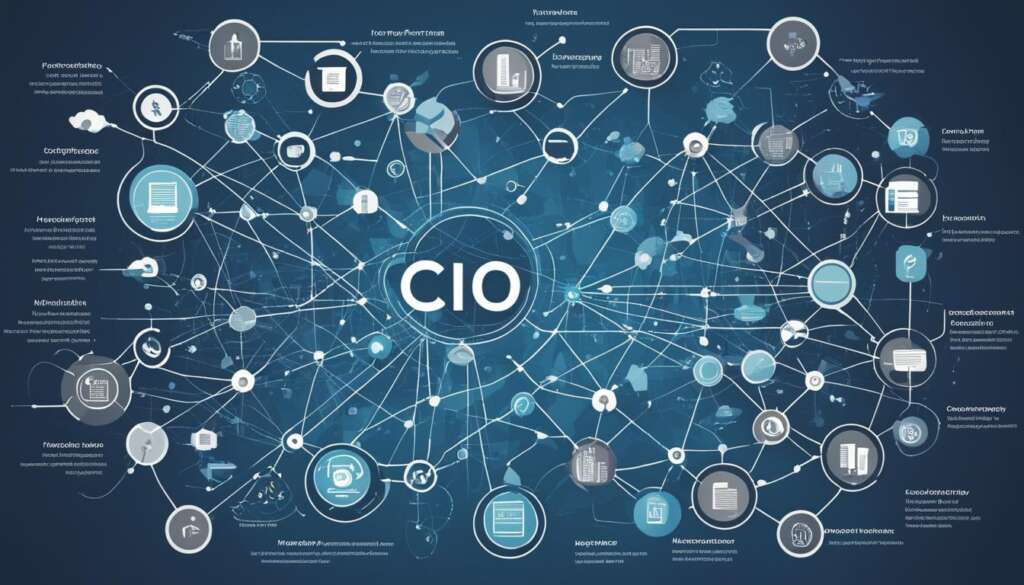Table of Contents
A chief information officer (CIO) is a high-ranking executive responsible for managing, implementing, and overseeing the information and computer technology systems of a company. The role of a CIO has increased in popularity and importance due to the rapid advancement of technology and its impact on industries globally.
The primary responsibilities of a CIO include analyzing how various technologies can benefit the company, integrating systems to realize these benefits, and ensuring the successful implementation of information and computer technology. They must be agile and responsive to trends, changes, and the needs of the organisation and its people.
Qualifications for a CIO typically include a bachelor’s degree in a technology-related field, and in some cases, a master’s degree in business administration. CIOs must possess both hard and soft skills, including business acumen, knowledge of technology trends, relationship-building abilities, and excellent communication skills.
The average salary of a CIO in 2022 is reported to be $287,500, with compensation increasing by 21% from the previous year. As technology continues to advance and play a crucial role in business operations, the demand for skilled CIOs is expected to grow.
CIOs play a vital role in shaping a company’s digital strategy and leveraging technology to drive innovation, efficiency, and growth. By understanding the responsibilities and qualifications of a CIO, organizations can prioritize hiring and supporting this crucial position to stay at the forefront of technology-driven industries.
The Evolution and Challenges of the CIO Role
The role of the Chief Information Officer (CIO) has undergone significant evolution over time. In the past, CIOs were primarily responsible for maintaining internal computers and networks. However, with the rapid advancement of technology, their role has expanded to include developing strategies and systems that keep businesses competitive in an ever-changing global marketplace.
Modern-day CIOs face a range of challenges that require strategic thinking and adaptability. One critical challenge is the modernization of legacy systems. These systems, often decades old, need updates to meet current standards and enhance efficiency. CIOs must navigate this process while ensuring seamless transitions for users and addressing public usability concerns.
Another pressing concern for CIOs is cybersecurity. As businesses rely heavily on technology, protecting data from cyber threats has become a top priority. CIOs must implement robust security measures and ensure compliance with privacy regulations to safeguard sensitive information.
Managing the expectations of various stakeholders is yet another challenge faced by CIOs. This includes balancing the needs and preferences of the younger generation, experienced employees, and external users. CIOs must find ways to strike a balance between the pace of technological change and the understanding and acceptance of those involved.
To overcome these challenges, CIOs need to adopt a strategic and forward-thinking approach. They must focus on modernizing legacy systems to improve efficiency, invest in robust cybersecurity measures, and effectively manage stakeholder expectations through clear communication and careful planning.
| Challenges Faced by CIOs | Solutions |
|---|---|
| Modernization of legacy systems | Implement phased modernization strategies to minimize disruption |
| Security concerns | Invest in cybersecurity measures, conduct regular audits and train employees on best practices |
| Managing stakeholder expectations | Establish clear communication channels, involve stakeholders in decision-making processes, and provide ongoing updates |
By addressing these challenges head-on, CIOs can play a pivotal role in driving innovation, achieving digital transformation, and enabling businesses to thrive in today’s technology-driven world.
Advice for Federal CIOs and Industry Support
The role of a Federal CIO is crucial in driving change within the government and harnessing the power of technology to implement new systems, processes, and data. Federal CIOs can enter this position through the Senior Executive Service (SES) path by gradually assuming greater responsibilities within the government. Alternatively, they can bring a fresh perspective by being recruited from outside the government.
Being a Federal CIO comes with unique challenges, including understanding the pace of movement within the government and establishing strong relationships with key stakeholders. Furthermore, Federal CIOs have the responsibility of managing large-scale modernization projects that modernize legacy systems while ensuring usability and data security.
For aspiring Federal CIOs, it is important to engage with colleagues and industry partners, communicate effectively, and build bridges to gain support for their initiatives. On the industry side, understanding the specific needs and challenges of CIOs, providing innovative solutions, and demonstrating the ability to deliver meaningful results are crucial for building strong partnerships. Building trust and aligning with the goals and available resources of the agency are key factors for successful collaboration between industry and CIOs.
FAQ
What is a CIO?
A CIO, or chief information officer, is a high-ranking executive responsible for managing, implementing, and overseeing the information and computer technology systems of a company.
What are the responsibilities of a CIO?
The primary responsibilities of a CIO include analyzing how various technologies can benefit the company, integrating systems to realize these benefits, and ensuring the successful implementation of information and computer technology.
What qualifications are required for a CIO?
Qualifications for a CIO typically include a bachelor’s degree in a technology-related field, and in some cases, a master’s degree in business administration.
How much is the average salary of a CIO in 2022?
The average salary of a CIO in 2022 is reported to be 7,500, with compensation increasing by 21% from the previous year.
What challenges do CIOs face?
CIOs face challenges such as modernizing legacy systems, training employees to adapt to new systems, addressing security and privacy concerns, and managing the expectations of different stakeholders.
What is the role of a Federal CIO?
The role of a Federal CIO involves driving change within the government and leveraging technology to institute new systems, processes, and data.
How can Federal CIOs enter the position?
Federal CIOs can enter the position through the Senior Executive Service (SES) path or through recruitment from outside the government for a fresh perspective.
What advice is there for Federal CIOs?
Advice for Federal CIOs includes engaging with colleagues and industry partners, communicating effectively, and building bridges to ensure support for their initiatives.
How can the industry support CIOs?
On the industry side, it is important to understand the specific needs and challenges of the CIO, offer innovative solutions, and demonstrate the ability to deliver meaningful results.













